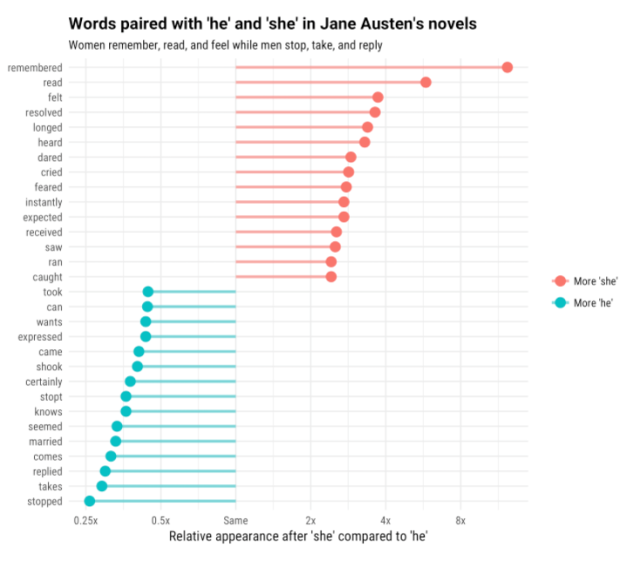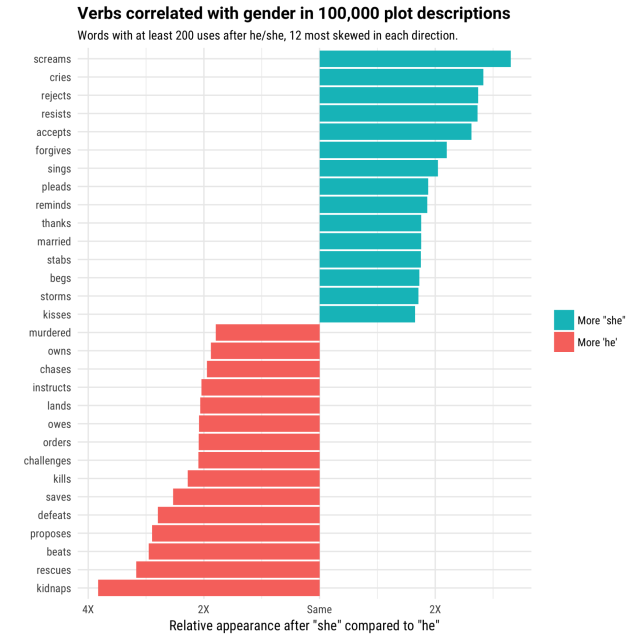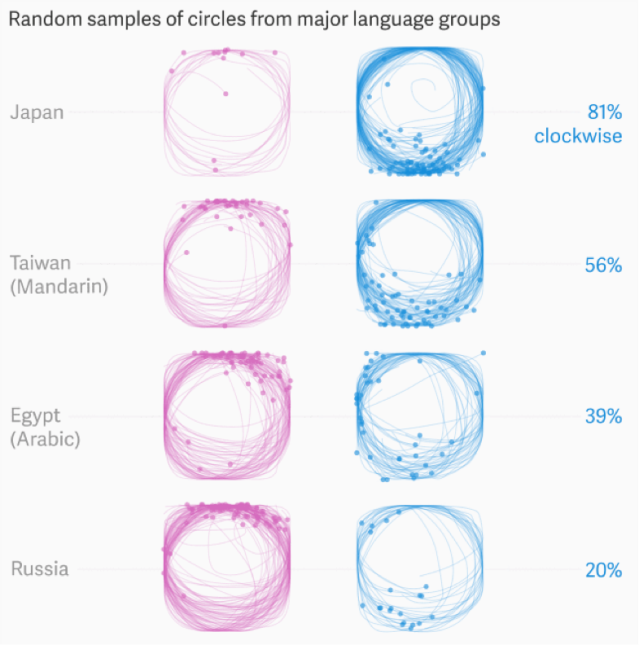“Sticks and stones may break my bones, but words will never hurt me!” – A child’s desperate retort.
Remember that refrain? Seems like a necessary staple that runs through every pre-adolescent’s life, reinforced by helpful friends and parents desperate to build up a tough skin.
Until one day the need for the refrain disappears, or seems to disappear.
The truth is, it doesn’t disappear. It just dips below the horizon, but words still exert their gravitational pull.
Julia Silge recently posted a follow-up piece about what verbs tend to occur after “he” or “she” in several novels. She looked at such cultural icons in 19th century English literature as six novels by Jane Austin, a few by George Elliot (another woman), and Charlotte Bronte’s Jane Eyre. (I recall in high school I only had to read one of these, and it took me a long time. Silge, on the other hand, along with a few other bloggers who dove into this activity, resorted to coding a program to scan through a digitized literature database. They also kindly provided examples and links to their code so we, if so motivated, could engage in a similar exercise.)
Then, David Robinson, a coding colleague of Silge, followed up on this intriguing analysis and looked at Gender and Verbs across 100,000 stories.
What, might you ask, would we/could we learn from this fascinating exercise and treasure trove of information, information about gendered pronouns, verbs, coding, and digitized databases of hundred of thousands of stories of which we were no doubt completely unaware?
On the surface we would discover the following: the verbs (action words, remember, that express physical or mental action) that follow “he” and “she” tell us what behaviors the authors associate with their characters.
For Jane Austin’s novels, the “Verb” versus “Character Gender” table looks like this (from Silge’s post. As a note for clarity, these are the verbs skewed, or most predominantly following “she.” Thus, the verb “remembered” is associated with “she” 8 times more often than it is associated with “he.” And the verb “stopped” is associated with “she” 4 times less often (0.25x on the scale) than with “he” (in other words, 4 times more often with “he”). It took me a while to clear that up, being a scientist trained to always scrutinize any data plotted on a logarithmic scale.)
For Jane Austin and her 19th century reader’s culture, women’s actions appear to be more intrinsic (that is, internally experienced), while men’s seems to be more extrinsic (that is, externally expressed).
The results from Robinson’s analysis appear as follows (with a more understandable scale):
While the most prevalent verbs (physical or mental actions) change, the underlying apparent character attributes in this analysis are not too different (intrinsic versus extrinsic, except perhaps for the “stabs” action on behalf of women).
Fascinating! So from whence do these different (and supposed) gendered actions arise?
I propose that the answer is that we did it to ourselves. Those “words that will never hurt me,” the words that were contrary to how we wanted to see ourselves, became replaced by words that aligned with how we did see ourselves (for better or worse). While the “words that will never hurt me” disappeared below the horizon, the “words that define me” continued to circulate, repeated and reinforced by our culture: those around us, those in our closest circle or relational network, our Dunbar group.
In essence, it is the result of Regression (or Coercion) to the Cultural Mean, of being helped to conform to what our “culture” expects of us.
These quick exercises do seem rather broad, and Robinson suggested some valid questions for further study:
- Is the shift (differing predominant verbs after “he” or “she”) stronger in some formats or genre than another? We could split the works into films, novels, and TV series, and ask whether these gender roles are equally strong in each.
- Is the shift different between male- and female- created works?
- Has the difference changed over time? Some examination indicates the vast majority of these plots come from stories written in the last century, and most of them from the last few decades (not surprising since many are movies or television episodes, and since Wikipedia users are more likely to describe contemporary work).
I, not surprisingly, came up with a couple of questions of my own:
- Presuming that the digitized database is comprised of only English language stories (which seems to be the case), is there a shift in stories in other languages (which express “how people think” and is closely intertwined with a culture)?
- Is there a shift associated within English speaking and writing subcultures?
- Is there a shift detected generationally (i.e., the age when the authors wrote)?
- And, to really nail down the current and active Regression to a Cultural Mean, is there a shift observed in current news and social media (which are already conveniently digitized).
Circles
Now, if you are beginning to think some people have too much time on their hands, the group is larger than you think.
The following exercise began with a simple request: Draw a circle. Go ahead. Take a pencil and piece of paper and quickly draw a circle. Don’t think too hard!
A post on Quartz by Thu-Huong Ha and Nikhil Sonnad followed up on this simple request. From their post,
Did you start at the top or bottom? Clockwise or counterclockwise?
In November, 2016, Google released an online game called Quick, Draw!, in which users have 20 seconds to draw prompts like “camel” and “washing machine.” While fun (Blog: for people who have too much time on their hands), its real intent is to use the sketches to teach computer algorithms how humans draw. By May of this year, the game had collected 50 million unique drawings.
Do you see the looming opportunity here? Time on one’s hands… 50 million drawings… Already digitized… And available on a public database… No time to lose.
And of great interest is what they found,
Our analysis suggests that the way you draw a simple circle is linked to geography and cultural upbringing, deep-rooted in hundreds of years of written language, and significant in developmental psychology and trends in education today.
The post is well worth the read, but some interesting facts are revealed in the data.
- Americans tend (86%) to draw circles counterclockwise
- Japanese tend (80%) to draw circles in the opposite direction (clockwise)
- British, Czech, Australian, and Finnish circles were drawn like American ones, counterclockwise, with the same consistency (~86%)
- Others are even more consistent: around 90% of French, German, and Filipino drawers submitted circles drawn counterclockwise
- In Vietnam, a full 95% were drawn this way
Most of the world, it seems, draws circles counterclockwise, with just two exceptions: Taiwan and Japan.
A major aspect that sets cultures apart is language, especially in its writing, and the correlation seems to be fairly strong. From their data:
The authors looked at language attributes such as reading and writing from left to right or vice versa, and stoke sequence in writing. Their conclusion,
Together these studies show not only that culture and handwriting shape the way people draw abstract shapes; they also suggest our tendencies get stronger over time. The more we write, the more our habits become ingrained.
There are countless ways that we subtly, unconsciously carry our cultures with us: the way we draw, count on our fingers, and imitate real-world sounds, to name a few. That’s the delight at the heart of this massive dataset. To test our theories, we approached colleagues, friends, and family who write in Japanese, Arabic, Hebrew, Chinese, Thai, and Vietnamese, and, feeling a bit silly, asked them to draw circles. They gladly jumped in, wondering what their fingers would do, and eager to feel part of something larger.
What is revealing in these two, seemingly innocuous and frivolous studies is that with increased access to large datasets (of seemingly innocuous information), significant patterns can be identified and associated with cultural roots. Arnold Toynbee spent much of his life looking at volumes of written historical records in order to develop his magnificent A Study of History (previously covered beginning here). Thomas Piketty used not only historical records recently digitized, but computers to identify patterns and trends for his heftier Capital in the Twenty-First Century (something I am working on reading, patiently).
What is also revealed is, as indicated earlier, culture, which helps define how we think and who we are, has a more influential role in societies and nations that we have been willing to realize. But culture also defines who is not one of us, and that needs to be even more greatly taken into account as we continue to deal with a more globalized and ever shrinking world.
It doesn’t do any good to throw up barriers and bury our collective heads in the sand. We need to take the time to connect, listen, and understand each other, whether it’s individually, political parties, or nations.



Next drawing study should examine squares
LikeLike
Are you refering to the drawings or the drawers? That, too, could be enlightening.
LikeLike